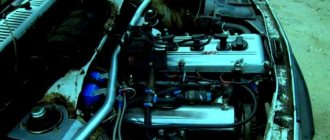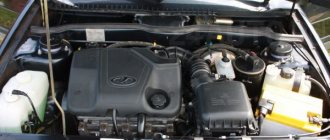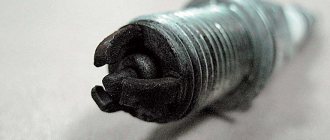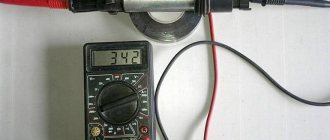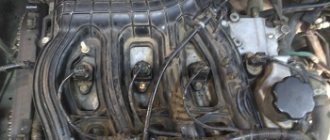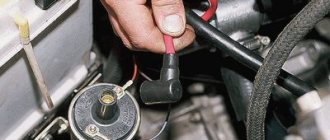Despite the huge amount of criticism against the Lada Priora, this is one of the most popular cars that have come out of the AvtoVAZ assembly line in recent years. The Priora is equipped with a fairly successful engine with good dynamics, and the interior is very comfortable. And the maximum trim levels offer useful options. But at the same time, from time to time the car brings minor problems to its owners. One of the most popular malfunctions is that the Priora engine (16 valves) is tripping. The reasons for this phenomenon are quite unpleasant. And besides, the motor eventually overheats.
When the driver starts his car in the morning, the engine does not run smoothly as before, but intermittently. At this time, dull sounds are heard from the exhaust pipe. At the same time, a persistent and strong smell of unburned fuel is felt. Vibrations are constantly increasing, and this is fraught with cracks in the pillows. This is how the engine runs when cold.
Trouble the engine: why is it dangerous?
This is a rather critical phenomenon, especially if the unit begins to vibrate during acceleration.
This behavior of the engine is especially dangerous when the driver decides to overtake, but there are cars in the oncoming lane. In the process, while the motor is running, the engine power is significantly reduced. The compression ratio decreases - there may not be enough dynamics to successfully complete the maneuver.
Considering that the Lada Priora has been manufactured since 2007, there are often instances where the engine knocks like on an old car 20 years ago. This is an engine running on three cylinders. It may have the latest firmware, but if the engine of a Lada Priora car is running rough and the check light is on, then such a car will not have much life left.
Supply system
If the Priora engine (16 valves) is tripping, the reasons may be trivial. When there is no flash in the cylinder, perhaps there is simply no fuel there. If it has a normal compression ratio, it is worth diagnosing the power system. You should pay maximum attention to the air filter and the pipe. It is necessary to make sure that the clamps are securely tightened, whether the purifier body itself is intact, and whether there is any air leakage from the outside. Also pay attention to the tubes. They must be tightly secured to the throttle assembly. Fuel leaks, cracks, and broken plastic may indicate that some parts are faulty.
Why isn't one cylinder firing?
A huge number of reasons can cause the failure of one of the cylinders. Typically, technicians consider options related to the absence or insufficiency of a spark and problems with fuel supply or mixture formation, but there are also unusual cases when it is not so easy to find the cause of the tripping.
Graph of acceleration of each cylinder after passing TDC
Here, for example, is a VAZ 21114 car, which three months ago experienced a water hammer and engine repair, and 5,000 km after the service station began to seriously trip. Diagnostics showed that the second cylinder was not working. Experts from various services have ruled out the following reasons:
- spark plug malfunction: incorrect gap, carbon deposits, failure of the explosive wire;
- problem with the ignition coil or its wiring;
- incorrect operation of the injector: clogging, poor spray, incorrect correction based on sensor data, wiring fault;
- air leakage at the inlet or through the VUT;
- insufficient compression of the mixture in the cylinder: carbon deposits, stuck piston rings, scuffing on the hone, burnout, incorrect valve adjustment, sticking of the hydraulic compensator;
- breakdown of the cylinder head gasket or a crack in the head itself;
- ECU malfunction or incorrect firmware operation.
Everything was normal, but the car jerked and did not pull.
Diagnostics with a motor tester showed that there was an unstable spark in the second cylinder, and a test with a pressure sensor showed that the complex gas losses in it with quite decent compression of 12 atmospheres turned out to be 27%. This is a lot, the maximum allowable figure is 20%. It turns out that the valve timing did not match only in the second cylinder.
What can cause valve timing failure on one specific cylinder? Camshaft cams and valve springs for this cylinder. The camshaft cams turned out to be normal, but the pusher on the exhaust valve dropped when lightly pressing it with a screwdriver. You need to dry it out and look, it looks like the springs on this valve are faulty.
After drying out, we discovered that the springs were very short compared to the standard ones, and the valve seal on this guide bushing had burned out. But all these malfunctions were also not the main cause, but only a consequence of overheating of the springs by exhaust gases, which burst between the guide sleeve and the valve stem due to excessive wear.
Valve springs removed from engine (right) compared to new
It turns out that first the oil seal burned out, then the springs sagged due to overheating and the valve stopped closing on time when the engine was running. This did not affect the compression, because when it was measured, the engine speed was low, and the valve had time to close. This misled other auto mechanics.
Cylinder head repair procedure
After repairing the cylinder head, all parameters returned to normal and the cylinder started working again.
Engine diagnostic window after cylinder head repair
Nozzle failures, clogging
When the Priora engine (16 valves) fails, the reasons often lie in the injector.
It may be faulty or simply blocked. Beginners and those who like to pour various injector cleaning fluids into the tank often encounter this problem. All this leads to the fact that the dirt first peels off in the tank, then in the fuel line. And eventually it will end up in the injectors, where it will happily get stuck.
Nutrition
A missed flash may occur due to the fact that there is simply nothing there to burn, that is, to flash. So first, start the engine. When it has been running for a couple of minutes, turn it off and remove the spark plug. If it turns out to be dry, then the reason is the lack of fuel. There may be several reasons for this situation:
- The most common cause of 16 valves on a Priora is damage to the injector winding. You can check this by removing the cover and manifold. Then measure the resistance on the injector winding; it should be within 15-15 Ohms. If it is faulty, it should be replaced. Read more about how to do this in the article “How to check an injector nozzle”;
- Another reason is a clogged injector. This usually happens when using low-quality fuel. You can also “clog” these engine elements yourself by pouring various cleaners into the tank. They partially destroy sediments. Which, in the form of a suspension, enter the injector, where they get stuck in the nozzles. To fix the problem, you need to flush the injectors. You can do this yourself without removing them from the engine.
Poor quality fuel
This is one of the possible reasons why the engine stalls at idle or while driving.
To return to normal operation, you can try changing the gas station. This usually helps clear up a lot of misunderstandings. It is better to fill the 16-valve Priora engine with good 95-octane gasoline. It's not worth pouring something with a higher octane number. This will only lead to overheating. You can also try replacing the air and fuel filters. Sometimes this solves the problem.
Reasons why the Priora 16 valve engine is tripping. Nothing new
It is useful for any fan of the domestic automobile industry to know the reasons why the Priora engine has 16 valves.
After all, this problem is quite common. Ask any driver what the reason is, he will immediately give several options for the malfunction. And also ways to solve them. Of course, by interviewing many people you can find out all the reasons. But they still need to be checked. In addition, very often the cause of engine tripping can be several conditions at once. To ensure that the problem is resolved, you need to check all possible options. Only in this case will you get rid of this problem. Causes and consequences
Reasons why the Priora 16 valve engine is tripping
, can be very diverse. Several systems are involved in the normal operation of the engine. Therefore, to identify the source of the problem, it is necessary to check the following systems:
- Supply system;
- Ignition;
- Sensors
Very often, it is on Priors with a 16-valve engine that the problem arises due to power problems. Therefore, you need to check it first.
The consequences of engine tripping can be unpleasant. Outwardly, this manifests itself as hassle. After all, the engine is unstable and shaking. Often the interior begins to smell of gasoline. Don't forget the money issue. The car noticeably increases its appetite and you have to visit the gas station much more often. It's much worse that it leads to more serious damage.
First, the fuel settles on the cylinder walls and seeps into the block, mixing with the oil there. Due to this, the lubrication of the unit deteriorates and parts wear out faster. It is also possible for a water hammer to form if a sufficient amount of fuel accumulates in the cylinder. In the simplest case, the remaining working cylinders bear a large load. As a result, their elements fail earlier. In any case, it is necessary to eliminate this problem in a timely manner.
Before you begin more specific troubleshooting, perform diagnostics using a laptop. This will help you determine which cylinder is not firing. Typically, such errors are recorded in the memory of the engine control unit. Having determined where the flash skip occurs, start working.
Nutrition
A missed flash may occur due to the fact that there is simply nothing there to burn, that is, to catch fire. So first, start the engine. When it has been running for a few minutes, turn it off and unscrew the spark plug. If it turns out to be dry, then the reason is the lack of fuel. There may be several reasons for this situation:
- The most common cause on Priora 16 valves is damage to the injector winding. You can check this by removing the cover and manifold. Then measure the resistance on the injector winding; it should be within 15-15 Ohms. If it is faulty, it should be replaced. Read more about how to do this in the article “How to check an injector nozzle”;
- Another reason is a clogged nozzle. This usually happens when using low-quality fuel. You can also “clog” these engine elements yourself by pouring various cleaners into the tank. They partially destroy sediments. Which, in the form of a suspension, enter the injector, where it gets stuck in the nozzles. To solve the problem you need to flush the injectors. You can do this yourself without removing them from the engine.
These are the main reasons for engine tripping due to power problems. It should be noted that winding damage is the most common malfunction on such motors.
Ignition
But it may turn out that when you unscrew the spark plug, you will see that it is wet. This indicates there is no spark. As a result, no fuel combustion occurs. The ignition check is carried out in the following order:
- First, let's visually evaluate the candle. It should be brown-sand color. If it is darker, then it may be faulty. It is advisable to check it on a special stand. The spark should be blue and white. If it is yellow or red, then this is a bad sign. You can, of course, try to clean it with sandpaper, but this may not give the desired effect;
- Try using another spark plug and check how the engine runs. If everything returns to normal, then the cause has been found. Also check the high voltage wire;
- After this, check the ignition coil. It is the weakest ignition part in the Priora. To check, we will reset the ECU errors. And with the ignition off, they swap the probably non-working ignition coil with a known working one. The engine starts for a couple of minutes. The diagnosis is repeated. If the flash miss “migrated” along with the coil, the problem is in it. Replace it with a new one.
Sensors
. Engine friction can cause 2 sensors. One of them is the idle speed sensor. If he makes a mistake, the engine will stall when cold. After warming up everything returns to normal. The problem may also be caused by the crankshaft position sensor. Usually the problem of these is visible during diagnosis.
Conclusion
. There are many engine-related malfunctions. At the same time, even seemingly harmless ones can cause a bunch of other problems. Therefore, it is important to know the reasons why the Priora 16-valve engine is tripping. This will help you quickly eliminate the problem, which significantly reduces engine life. It also brings closer the need for major repairs.
Ignition system
An experienced car enthusiast who is faced with an engine running on three cylinders immediately begins to diagnose the spark plugs. The Lada Priora must cool well, otherwise there is a risk of getting burned when unscrewing it. If after a few seconds you turn off the ignition and check the spark plugs, one of them will be wet with gasoline. It is also recommended to separately check each part for the presence of a spark.
In case of malfunction, the problem is solved by replacing the spark plug. Sometimes it is enough to press down a potentially faulty one with a cap and the machine will resume normal operation. In general, the ignition system in this car is the most problematic part. If the Priora engine (16 valves) is malfunctioning, you can look for the reasons for a very long time, and diagnostics will not yield anything, even if it is done correctly. And only by replacing all elements can a positive result be achieved.
Main causes of misfire
There can be many reasons for the problem; even professional mechanics spend more than one hour to identify its source.
The main reasons for misfire in cylinders 1, 2, 3, 4 can be:
- The ignition coil or module has failed.
- Inoperative fuel injector, clogged due to low-quality gasoline.
- Incorrect spark plug gap, which can lead to poor sparking.
- Spark plugs are flooded.
- Breakage of high-voltage wires, increased resistance (non-standard ones are installed), oiliness of contact points.
- A high-voltage wire has fallen off (often happens on Lada Kalina and Granta).
- On an 8-valve engine, the timing belt may jump (during replacement, an error was made due to marks or as a result of excessive wear);
- On a 16-valve engine, the hydraulic compensators are not working correctly.
- Air leak (can be anywhere);
- The compression in the engine cylinders has dropped or is different (applies to cars with high mileage);
- Low pressure in the fuel rail as a result of reduced fuel pump performance.
- Black spark plugs due to carbon deposits on them.
Diagnostics of spark plugs by plaque
When the engine starts cold or hot, you can check the carbon deposits on the spark plugs. If the coating is white, then this indicates a lean mixture and overheating of the engine. A black tint indicates a rich mixture. In both the first and second cases there are problems with the operation of the electronics. This is either installing new firmware, or replacing the ECU. A normal candle has a brick color. By the way, the engine may stall at idle if the part is damp. This also significantly increases the warm-up time. In addition to the spark plugs, the ignition coil may also be acting up. Priora (8 valves) is equipped with distributor ignition. Overheating of the coil is often observed. You can restore the operation of the motor by simply replacing the element.
How to prevent the engine from stalling
After you check the motor and find out why it is misfiring, you should fix the problem. When spark plugs or explosive wires fail, it will be easy to solve the problem: just replace them. We take exactly the same actions if the ignition coils or switch are broken. However, when the fuel or air system is clogged, it will not be possible to quickly eliminate the breakdown. To clean the injectors, you will have to use a cleaning compound, such as Injection System Purge. It may also be necessary to replace the lambda probe, because it most likely functions incorrectly.
Have you cleaned the injectors, but this did not help fix the problem and the fuel mixture is flooding the spark plugs? Then we replace them. If the engine fails, the fuel pump and other components of the fuel system should be removed and new ones installed. It is not recommended to repair or install old elements. It may also be necessary to replace the air filter and parts of the air supply system if depressurization occurs.
At the very end, we remove errors in the electronic control unit; this may also be the reason that the motor is not working.
Checking the ignition coil
There is simply no special method by which you can check the operation of parts. The instructions for the car indicate one of the methods for self-diagnosis. So, with the ignition turned off, check whether the ignition coil (Priora is no exception) is firmly attached to the engine.
Then they look at the reliability of electrical connections in the low-voltage circuit. If everything is in order, then check for a spark. To do this, the ignition coil is removed. A test plug is inserted into the tip and pressed against a metal part of the engine. Next, turn the starter. If there is no spark, replace the coil. If there is a flash, but the engine does not start, change the spark plug.


